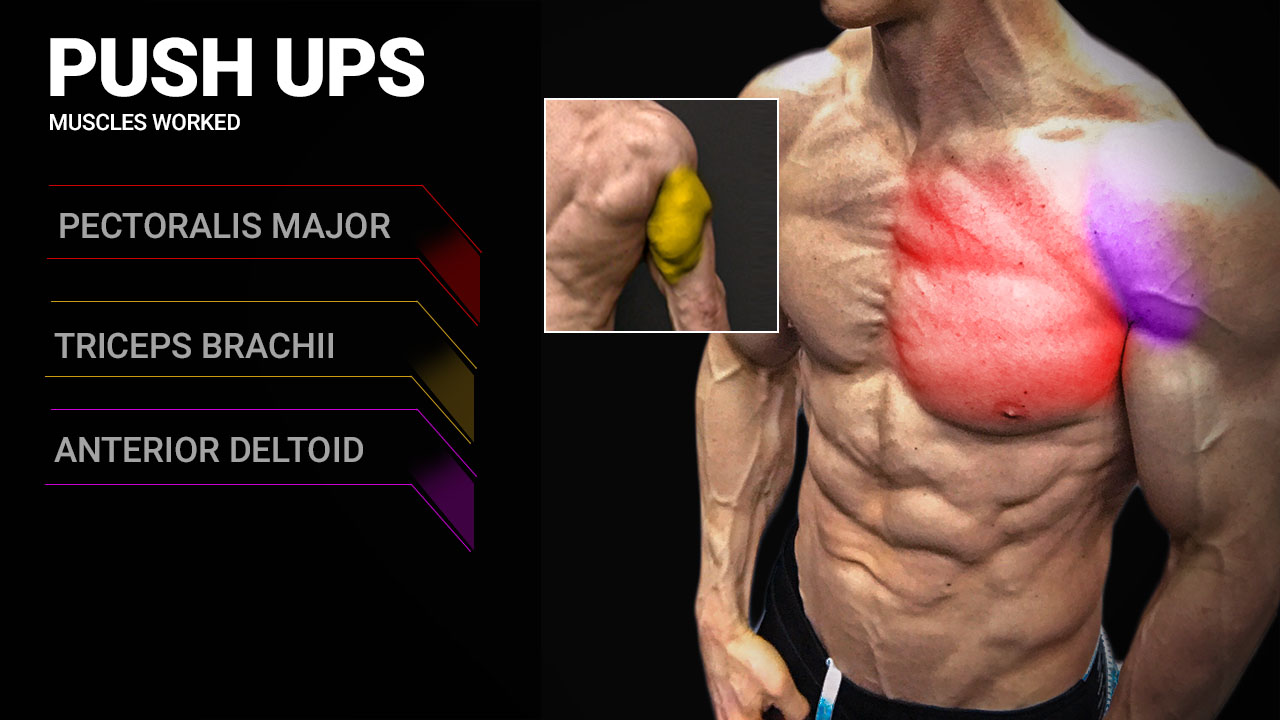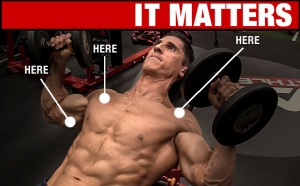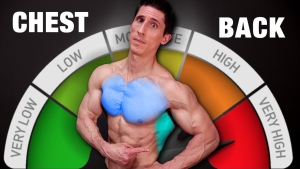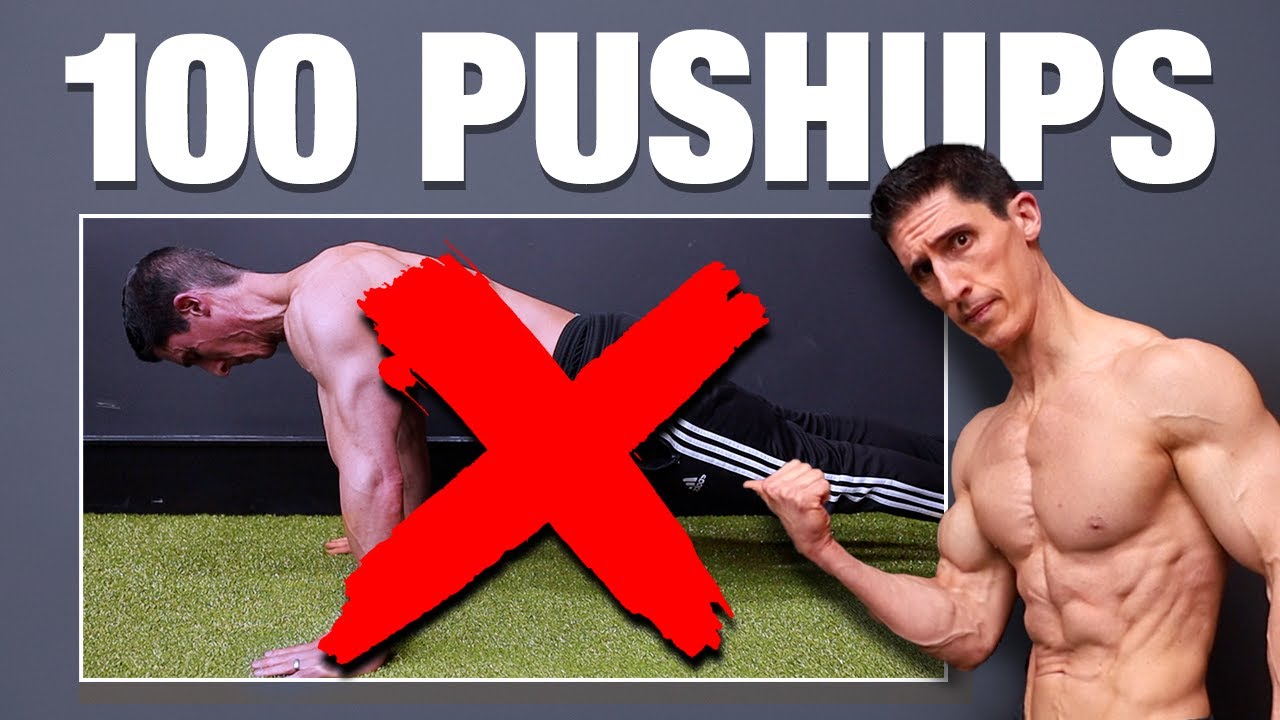
BEST 30 DAY PUSHUP CHALLENGE?
What’s not to love about doing 100 Push Ups a day?
It’s a minimalistic, simplified Push Up challenge. All you have to do is get down on the floor and perform a single exercise for 100 repetitions every single day.
That’s it!
And hey, don’t forget about the results you’re seeing online. People are building their dream body with serious chest muscles and arm muscles while increasing upper body strength.
Sounds great, right? Well, guess what, guys.
I’ve got a problem with this popular 30 day Pushup challenge. The truth is that doing Push-Ups like this is not all it’s cracked up to be.
I want to explore the problem with this popular Push Up challenge, but more importantly, I want to present a better solution for you.
WHAT MUSCLES DO PUSH UPS WORK
You’ll notice that Push-Ups work primarily “frontal muscles,” and in particular, the major muscle group known as the pectoralis major.
There is also a lesser-known muscle group beneath this called the pectoralis minor, but it tends to get less attention than its aesthetic counterpart.
The pectoralis major muscle fibers are composed of three distinct sections: upper, middle, and lower.
Muscle activation in a specific section depends on the exercise being performed and the intensity at which it is done.
For instance, doing a Push-Up from a raised surface will emphasize a different part of the chest muscle compared to a conventional Push-Up done on a flat surface.
With that said, let’s take a closer look at your chest muscle:
UPPER CHEST


The upper chest muscle, also known as the clavicular head of the pectoralis major, is an important part of the overall chest muscle group.
It is located directly below the collarbone and its primary functions include the following:
- Shoulder flexion (raising the arm forward)
- Horizontal adduction (bringing the arm across the body)
- Assisting with shoulder rotatio
Additionally, the upper chest muscle plays a significant role in stabilizing the shoulder joint during overhead lifting or pushing movements.
Developing the upper chest muscle not only contributes to a well-rounded and aesthetically wowing physique but also enhances functional strength in activities that require lifting or pushing overhead.
Key exercises that target the upper chest include the Incline Bench Press, Incline Dumbbell Fly, and Incline Push-Up.
MIDDLE CHEST


The middle chest muscle, primarily composed of the sternal head of the pectoralis major, is the most prominent and central part of the chest muscle group.
It spans across the sternum, stretching from the clavicle bone to the ribcage, and plays a vital role in the following functions:
Horizontal Adduction: This is the action of pulling your arm across the front of your body. It’s the primary motion used in exercises like the Bench Press and Chest Fly.
Flexion of the Humerus: This involves moving your arm or shoulder forward, as in the upward phase of a Push-Up or the act of throwing a ball underhand.
Medial (Internal) Rotation of the Humerus: This is the action of rotating your arm inwards towards the center of your body.
Adduction of the Humerus: This involves drawing your arm down towards your body from a raised position, like when you’re doing a Pull-Up.
LOWER CHEST


The lower chest muscle extends from the lower sternum to the outer ribcage and attaches to the upper arm bone (humerus).
It’s responsible for the following functions:
Shoulder Extension: The lower chest muscle assists in moving the arm backward or extending the shoulder, as in the motion of swinging a bat or pushing something away behind you.
Shoulder Adduction: This involves drawing the arm towards the body from a raised position, such as when lowering your arm from a lateral raise.
Horizontal Adduction: The lower chest muscle also contributes to pulling the arm across the front of the body, similar to the motion used in exercises like Decline Bench Presses and Chest Flyes.
Stabilization: The lower chest muscle plays a role in stabilizing the shoulder joint during various upper body movements, particularly those involving
downward or inward motion.
HOW TO PERFORM A PUSH-UP
Before I jump into why I’m not a fan of 100 push ups a day, let’s break down how to do this bodyweight exercise.
Guys, I highly recommend reading this part because I have a feeling some of you are making some common push-up mistakes. This will help clear it up.
There are Pushup variations that you can do, but here’s how to do Nonmodified Push-Ups:
PUSH-UPS


HOW TO DO PUSH-UPS:
- To perform a standard Push-Up, the starting position is a high-plank position: hands flat under the shoulders in a neutral position and the body is straight from head to heels with contracted buttocks muscles.
- Lower your upper body towards the floor, keeping elbows tucked in and pushing them back. Descend until your chest touches the floor, elbows at a 90-degree angle.
- Then, push back up, maintaining alignment. Don’t lock your elbows or go into a hunched-over position.
- If it is too difficult, modify by dropping to your knees for the Knee Push-Up. You can also do them against a wall or on a weight bench. Also, if you have Perfect Push-Up bars, or something similar, feel free to use those for a better hand position.
WHAT MAKES IT EFFECTIVE: Regular Push-Ups are effective because they engage multiple muscle groups, including those in the chest and triceps. They also target the front deltoid muscles and abdominal muscles, providing a comprehensive upper body workout for a number of goals including muscle size, muscle strength, and muscle thickness.
COMMON PUSH-UP MISTAKES
I want to make sure you know how to do a Push-Up, but I also want you to be aware of common mistakes that people make when doing Push-Ups.
Here are some tips on proper techniques and things to watch out for:
START SMALL
It’s okay to start with modified variations if you’re new to Push-Ups and gradually increase difficulty from there.
Fitness levels matter here, so if you’re new to working out, consider starting with the Knee Push-Up.
You’ll see steady progress and a better overall recovery process as opposed to pushing yourself to attempt an exercise that’s too advanced.
DON’T FORGET TO WARM-UP
This is a compound bodyweight exercise so be sure to prioritize warming up and stretching.
Even though you are only using your body weight, you need to prepare the major muscle groups involved, especially the rotator cuff.
FULL RANGE OF MOTION
Another mistake when learning how to do a Pushup is not performing the exercise through its full range of motion.
In order to get the benefits of the Pushup for optimal muscle growth and development, you have to make sure that you are bringing your chest all the way down to the floor and extending your arms to full lockout at the top.
This will allow for the most muscle activation and growth.
NECK AND HEAD POSITION
Neck and head positioning could be hindering your ability to grow muscle using the Pushup due to its ability to cut the range of motion once again.
By craning your neck and moving your head around, you are creating the illusion of being close enough to the ground which means that your chest has not reached the ground.
Make sure to maintain a neutral head position. This goes for the neck too.
WATCH YOUR SHOULDERS
Guys, you need to un-shrug your shoulders. By keeping your shoulders shrugged, you are losing key stability in the exercise as well as allowing the shoulders to dominate the movement
So, to make sure you get the most out of this exercise, keep your shoulder blades back and down throughout.
ROTATOR CUFF STRAIN
Continuing with the shoulders, the Pushups Challenge can put a lot of strain on your rotator cuff.
To avoid rotator cuff strain while performing push-ups, it is crucial to maintain proper form and technique. Keep your elbows tucked near your body at a 45-degree angle.
You should also maintain a neutral position in your shoulders while keeping your core tight for stability.
LISTEN TO YOUR BODY
Stop if you experience persistent or sharp pain. By focusing on quality over quantity and following these tips, you can reduce the risk of rotator cuff strain and ensure a safe and effective push-up routine.
MY PROBLEM WITH 100 PUSH UPS A DAY
Now I get it, you might be thinking that I don’t like Traditional Push-Ups.
I actually love the Push Up exercise and classify it as one of the most effective exercises you can do.
In fact, I think it’s one chest exercise that everyone should be doing so long as you spend time to master the technique.
My issue isn’t with the Pushup itself; it’s with what the 100 push up challenge promotes.
There are a few big problems with approaching this classic exercise this way.
AVOIDING VARIATION
When you can do 30, 40 or 50 push-ups in a single set then I would argue that you’re not choosing a hard enough variation of the Pushup in order to keep the gains coming.
You shouldn’t be able to easily knock out that many Pushups if your goal is consistent progress. In other words, the Push-Up needs to be a challenging exercise.
Sure, it’s an amazing physical feat, but being able to do that many Push-Ups with ease is a sign that your muscles aren’t being challenged in the way they should be.
Instead of doing 100 Push Ups a day, I’d recommend choosing a Push-Up variation that increases the intensity and difficulty.
LOWER QUALITY REPS
If you look at the number alone, you might be deceived as to the effectiveness of that simplified 100-a-day approach.
This is just an arbitrary number. It’s not going to match the ability levels of everyone. Some of you will be able to do far more and some of you will be able to do far less.
For those who can’t do that many, you’re going to be struggling with each rep. This means you’re probably going to use sloppy form. This also means that you won’t get those high-quality reps you need for results.
On the other side, if you can do way more than 100 Push Ups a day, then you too won’t be getting the quality reps you need.
You’ll be able to quickly speed through the 100 reps and call it a day. Your muscles won’t be challenged, and you won’t see any progress.
OVERUSE INJURIES
When we talk about 100 Push Ups a day, we’re talking about a volume-focused approach to working out.
With 700 Push-Ups per week, you’re accruing a lot of volume. That means you need to be careful that you’re not introducing some unwanted side effects in the form of unusual fatigue in weeks, not over the course of months.
You might also notice excessive onset muscle soreness and overuse injuries.
Many people can develop some irritation and inflammation in the shoulders, elbows, and wrists.
So, what’s the solution here? What can you do to safely challenge yourself and see better results?
Trust me, guys, there’s a better way to do this.
A BETTER PUSH UP CHALLENGE
What I want you to do is think of 100 Push Ups a day differently.
Stop thinking about doing a hundred reps of Pushups all at once. Instead, I want you to imagine doing five sets of Push-ups that match your ability level.
Then I want you to think about doing them over the course of the day, not all at the same time.
What that means is, I want you performing five sets of Push-Ups but I want you to stop each set five reps short of failure.
Here’s what that looks like:

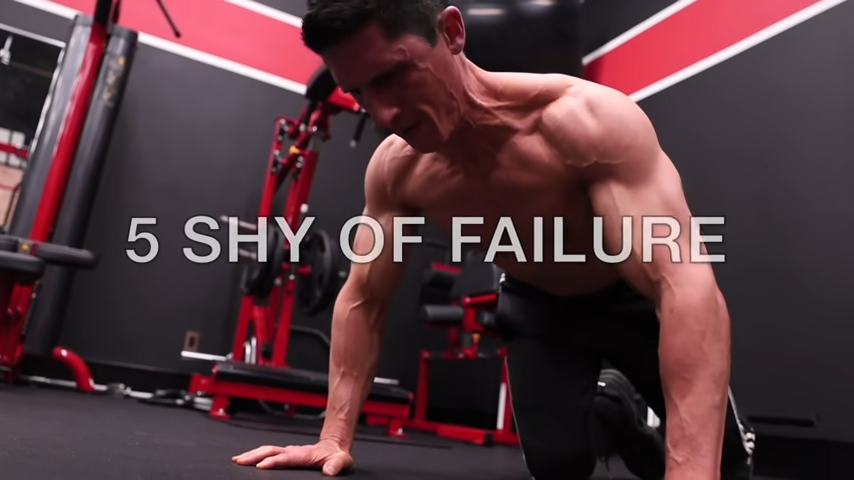
We all know that common burn that we start to feel throughout our arms and up to our chest. We start to feel fatigued, and we know we have more in us, but we don’t want to do too many.
Once you hit that fatigue, continue to crank out a few more reps, but stop when you feel like you have five or so left in the tank. This is your ideal stopping point after every set.
However, if you were to continue, this is what it might look like for you.
You’ll notice your form starts to give a bit and the burn intensifies. This is what it looks like to stop three repetitions short of failure.

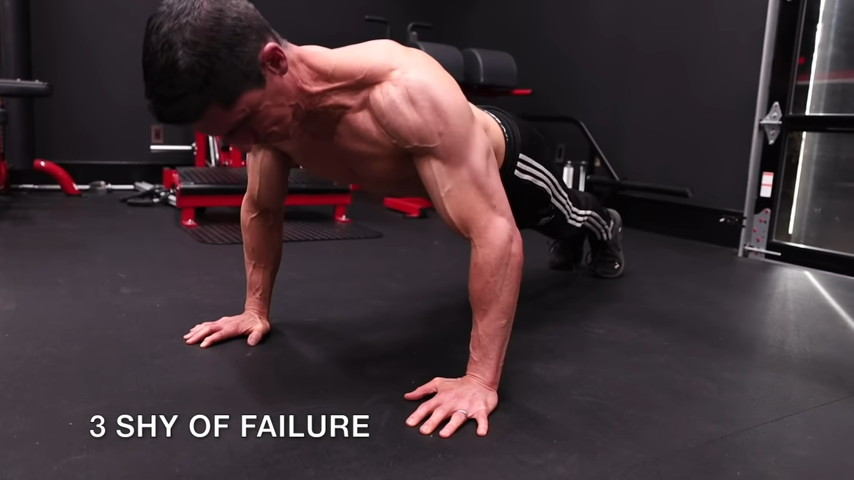
And when I take the set to absolute failure where I can’t even get myself up off the floor at the end.
This is not where you want to stop at the end of each set.
You need to make sure that you’re stopping at that first point – five repetitions short of failure – to really feel as if you’re leaving some in the tank.
That might mean you can only do 5 to 10 push-ups and that’s okay. Again, start with what you’re able to do and progressively challenge yourself.
WHEN TO DO YOUR PUSH UP CHALLENGE
You could do this in one of two ways:
First, you can do all of your Pushups in one workout session. The benefit here is that you’ll knock them all out at once and you don’t have to worry about them.
What’s more, that burn will be super intense.
The other way is to break them up over the course of the day.
The main reason I support doing it over the course of the day is because your repetitions will be of the highest quality every set. You won’t be burned out from previous sets.
What’s more, you’ll be able to perform more Push-Ups overall.
Now, keep in mind that if you were to break these up over the course of the day, you better have pretty good discipline to be able to get on the floor five separate times.
FRONT TO BACK: DON’T FORGET ABOUT THESE
As a physical therapist and trainer, I always have an eye towards the repercussions of doing certain exercises.
Doing that much volume in the front of your body, you’re neglecting the opposite side and increasing your risk for overuse injuries.
So, what do you do?
You can avoid these complications by simply doing 100 reps of another exercise.
You can do your 100 Push-Ups, but I want you to also do 100 repetitions of the Superman Press Out.
Don’t worry. You don’t have to do all of these at once.
I want you to do 20 reps of the Superman Press Out after every set of Push-Ups. Since you’re performing five sets of Push-Ups, this is going to add up to one hundred total reps.
The Superman Press Out works all those oftentimes overlooked muscles of the back.
Even the most ardent gym goer will train their middle back muscles, lats, and maybe their traps, but they’re not really focusing enough on the rhomboids or, more importantly, the rotator cuff.

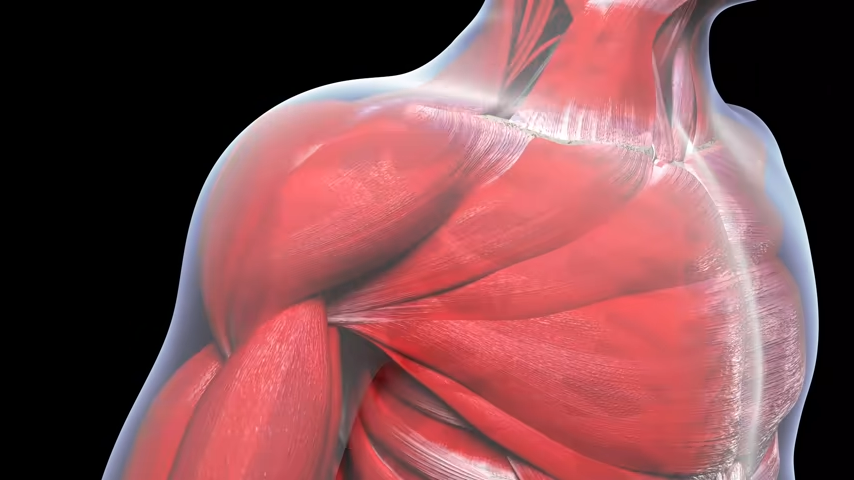
Skipping these muscles leads to postural imbalances. As I mentioned above, these imbalances and overuse injuries tend to be a result of these 100 Pushups a day routines.
By performing a superset of Push-Ups with the Superman Press Out, we’re not going to let that happen to you.
The five-set approach that more closely matches your ability level is one that I highly recommend.
However, if you still have an infatuation with doing 100 pushups, I suggest that you find a more difficult version of the Pushup – one that allows you to do 20 repetitions max in a single session.
If you’re looking for more challenging variations, we can help! Check out our ATHLEAN-X programs to see which is the best match for your goals and fitness level.

- There is an understandable attraction to a simple-to-follow exercise plan that can deliver bigger chest and arm gains. That said, doing 100 Push Ups a day is not the best use of your time.
- The main issue with making the number one hundred push-ups is that it won’t match the ability level of most people. It’s either going to be too challenging or not challenging enough.
- With that said, the benefits, gains, and results from this type of program are almost wholly due to the dramatically increased volume of the pushup exercise that comes with doing them daily.
- Over time, the sub maximal volume, done in much greater amounts, is enough to drive muscle adaptation and size gains in the chest, arms, and shoulders. That said, not all increases in volume can do this.
- Here’s the other issue with this type of program: Many times, the excessive volume becomes simply junk volume. That is, an accumulation of reps that are so below your capability levels that they serve to do nothing to progress the muscles that you are trying to build. Instead, they only cause irritation, inflammation and aggravation of the joints involved in the exercise.
- There’s a better way to see the same (if not better) results without tearing up your muscles and joints. Rather than as a firm fixed number of 100, shift that fixed number of reps to performing five sets of push-ups and stop each set five reps short of failure.
- I also want you to pair your push-ups with another exercise – the Superman Pressout – to avoid any of the imbalances that could come.
- So, you’ll perform one set of push-ups and stop around five reps short of failure. Immediately after this, perform 20 repetitions of the Superman Pressout, then take a break. You can move into your next set or complete the remaining sets throughout the day.
100 PUSHUPS A DAY FAQS
Doing 100 Push Ups a day with correct technique can boost upper body strength, muscle mass, and endurance.
However, it also presents a risk for overuse injuries. A better way is to perform five sets of push-ups where you stop five repetitions short of total failure.
Performing 100 Push Ups a day will be good for some and not recommended for others. While it might help to increase muscle development, strength, and aesthetics, the total amount of volume increases your risk for strain and injury.
It would be safer to perform five sets of push-ups, stopping five reps short of muscular failure. This is a better system, and you’ll see the same, if not better, results.
Completing 100 Push Ups a day can lead to increased muscle mass and upper body strength, specifically in the chest, shoulders, triceps, and core. It can also improve endurance and cardiovascular health.
With that said, I wouldn’t recommend doing 100 Push Ups daily because you could increase your risk for muscle imbalances, strains, and injuries.
Whether or not 100 push ups a day "works" depends on your experience level and fitness goals.
If you’re of an intermediate fitness level and your goal is to increase upper body strength, muscle mass, and endurance, it can be effective.
But if you’re new to working out, it’s going to be tough to maintain proper form and avoid overuse injuries.
If you’re at an advanced level of fitness, then this might be too easy, and you won’t see any results from it.
If you do 100 Push Ups a day, you may experience improvements in upper body strength, muscle mass, and endurance. However, this intense routine can also lead to potential overuse injuries, muscle imbalances, and plateaus in progress.
To reduce these risks, it is essential to use proper form, incorporate rest days, and include other exercises in your exercise routine to target different muscle groups and provide a more balanced approach to your workouts.
REFERENCES

Jeff Cavaliere M.S.P.T, CSCS
Jeff Cavaliere is a Physical Therapist, Strength Coach and creator of the ATHLEAN-X Training Programs and ATHLEAN-Rx Supplements. He has a Masters in Physical Therapy (MSPT) and has worked as Head Physical Therapist for the New York Mets, as well as training many elite professional athletes in Major League Baseball, NFL, MMA and professional wrestling. His programs produce “next level” achievements in muscle size, strength and performance for professional athletes and anyone looking to build a muscular athletic physique.
















